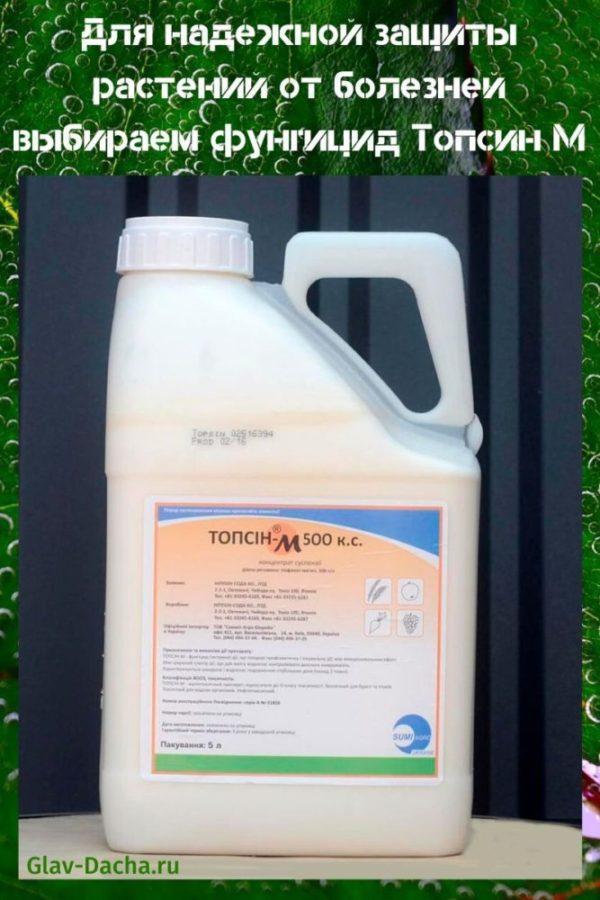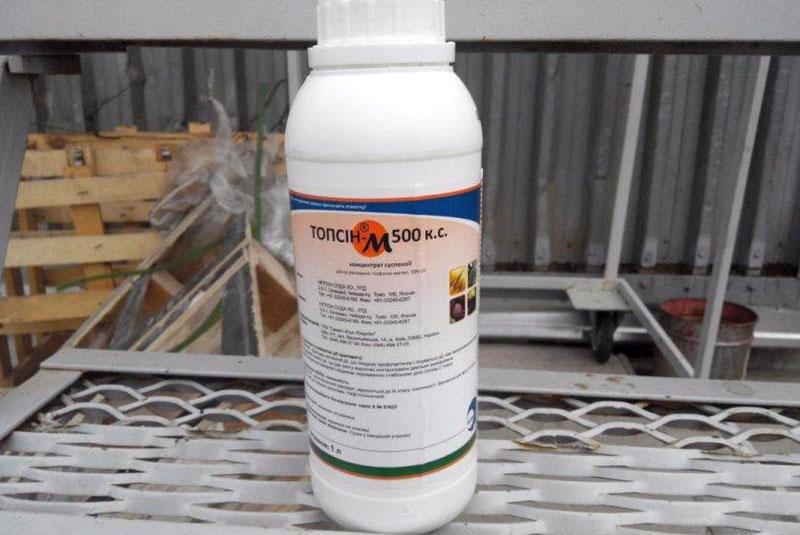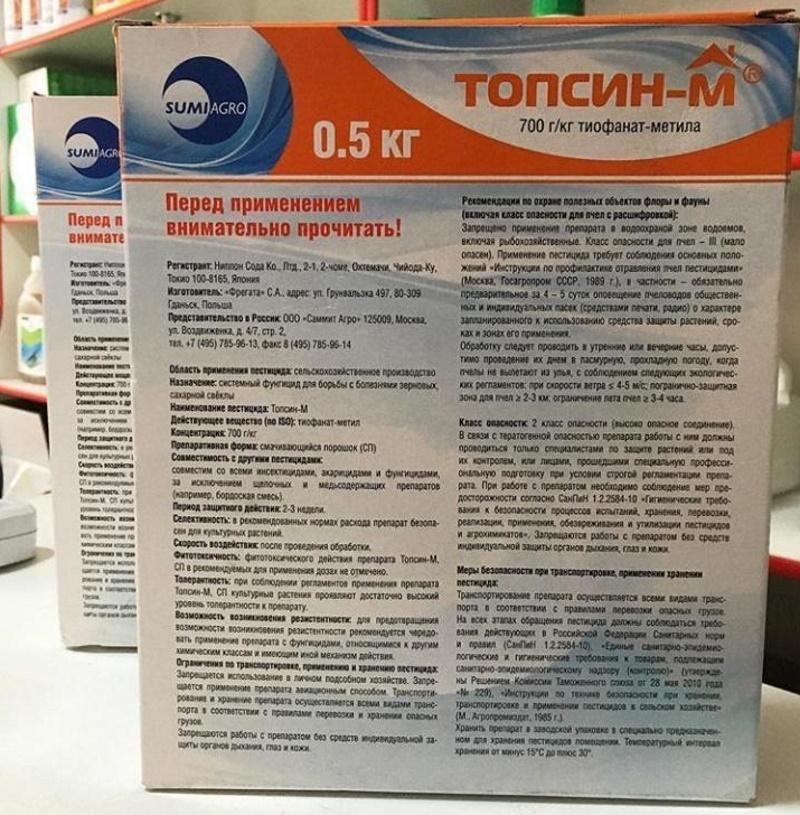For reliable protection of plants from diseases, choose Topsin M fungicide
 During the active growing season, changes in temperature and air humidity lead to the incidence of fruit crops, open cucumber beds, and cereal crops with fungal diseases. Fungicide Topsin M is an effective chemical preparation for combating powdery mildew, scab, gray mold, atracnosis.
During the active growing season, changes in temperature and air humidity lead to the incidence of fruit crops, open cucumber beds, and cereal crops with fungal diseases. Fungicide Topsin M is an effective chemical preparation for combating powdery mildew, scab, gray mold, atracnosis.
Composition and active substance

The chemical is sold as:
- a wettable powder containing 70% methyl thiophanate;
- 50% suspension concentrate.
For gardeners in powder form, packages of 10, 25, 500 grams, suspension solution in one- and five-liter cans or in bottles with a capacity of 10 ml or more are offered.
The pesticide methyl thiophanate contains carbendazim, which inhibits the growth of mycelium and inhibits fungal spores until complete death. Spreading through the root system, the vegetative organs, the drug blocks the reproduction of harmful fungal spores, protects against insects, and heals infected plant areas.
Topsin M fungicide: instructions for use
 When performing all actions with a chemical, calculating consumption rates, you should adhere to the recommendations indicated on the package.
When performing all actions with a chemical, calculating consumption rates, you should adhere to the recommendations indicated on the package.
Solution preparation and work procedure

Spraying efficiency is influenced by adherence to consistency, accuracy, compliance with safety measures at all stages of work:
- in a small bowl (for example, a half-liter glass jar), pour water warmed up to less than 20 degrees;
- dilute the required dose of Topsin M fungicide indicated on the package;
- stir the contents of the container evenly and thoroughly;
- fill the sprayer with a quarter of water and add a stirred concentrated solution from a can;
- mix thoroughly before spraying and during processing.
Plants should be sprayed on the day of preparation of the solution before or after flowering in calm clear weather.
Fungicide acts on fungal diseases during the first day. During the growing season, it is recommended to carry out two root treatments 15 days apart. More frequent treatments are useless, they can lead to addiction of fungi and harmful insects to the drug.
Recommended distance of treatment zones with Topsin M from:
- housing, premises for animals - 50m;
- water sources - 1500 m;
- bee apiaries - 2500 m;
- recreation areas, playgrounds - 150 m.
Features of processing different types of plants
 For cucumbers, root crops, 30 ml of emulsion per 1 square meter of crops is enough. For grapes and berries, 5 liters of the prepared solution is enough for a bush, for trees - up to 10 liters. Cereals are sprayed with a solution containing 3 g of substance per 1 liter of water.
For cucumbers, root crops, 30 ml of emulsion per 1 square meter of crops is enough. For grapes and berries, 5 liters of the prepared solution is enough for a bush, for trees - up to 10 liters. Cereals are sprayed with a solution containing 3 g of substance per 1 liter of water.
 It is most useful to spray ground cucumbers with Topsin M immediately after the emergence of young shoots before flowering. The chemical reliably protects them from powdery mildew, and sugar beets and other types of root crops from cercospora.
It is most useful to spray ground cucumbers with Topsin M immediately after the emergence of young shoots before flowering. The chemical reliably protects them from powdery mildew, and sugar beets and other types of root crops from cercospora.
Fruit trees are cultivated in spring before bud formation begins.
Berry bushes, grapes for protection from anthracnose, gray rot, powdery mildew are processed before the berries appear, so that toxic substances do not remain in them during the ripening period.
It is optimal to spray sugar beets in the phase of formation of 2 pairs of leaves in a mixture with auxiliary adjuvants and boron fertilizers.
Grape cuttings are treated at the rate of 20 g of Topsin M fungicide per 10 liters of water.
 Cherry plum, plum saves from cloterosporia, fruit rot, cherries from cocomycosis, brown leaf spot, pear from black crayfish.
Cherry plum, plum saves from cloterosporia, fruit rot, cherries from cocomycosis, brown leaf spot, pear from black crayfish.
Another area of application of the drug on plants is after hail to prevent the formation of white rot.
 Also suitable for sunflower (against white rot, phomopsis, verticillosis) and spring barley (protects against leaf blight). In autumn, winter wheat crops are treated based on the consumption of 1 liter of concentrate per 1 hectare of sowing to combat root rot.
Also suitable for sunflower (against white rot, phomopsis, verticillosis) and spring barley (protects against leaf blight). In autumn, winter wheat crops are treated based on the consumption of 1 liter of concentrate per 1 hectare of sowing to combat root rot.
After finishing treatment, it is recommended to thoroughly rinse the sprayer.
The substance should be stored in a closed container in a dark, dry place, at temperatures ranging from minus 15 to plus 30 degrees.
Advantages and disadvantages of using Topsin M

The main advantages of the fungicide Topsin M:
- In addition to fungal diseases, it successfully protects against lacewings, aphids, nematodes, leaf beetles. With proper processing of grain crops during the heading period, it prevents the development of fusarium, lowers the level of mycotoxins and helps to increase yields.
- It cures plants already affected by fungal spores, stimulates their growth and is a good prophylactic agent, improves immunity.
- The protective properties of Topsin M are effective for one month.
- Compatible with other fungicides (except those containing copper), insecticides.
- Improves the process of photosynthesis, stimulates cell growth.
- Fruit trees are guaranteed to protect from powdery mildew, scab, fruit and root rot.
- Safe if necessary precautions are taken.
- Economical in cost and consumption rates.
The use of the drug in large doses is harmful to people, inhabitants of a nearby reservoir. Due to inhalation toxicity, it is classified as hazard class 2. It is recommended to carry out the treatment in the morning or evening hours using overalls, glasses, gloves and a respirator.
Disadvantages:
- Not effective against downy mildew, dangerous for fish in nearby water sources.
- Incompatible with Bordeaux fluid.
- May lead to decreased egg production, decreased milk yield if the spray area is located next to a poultry house or livestock farm.
Do not treat in strong winds or near flying bees.
Fungicide Topsin M is an inexpensive complex pesticide that not only prevents the formation of fungus, but also protects against harmful insects, and is a good growth stimulant. The tool has been repeatedly tested on large areas of agricultural crops and in vegetable gardens, and has confirmed its effectiveness.